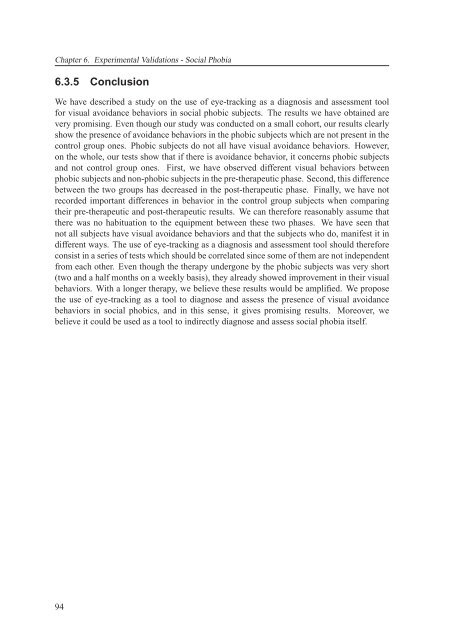Texte intégral / Full text (pdf, 20 MiB) - Infoscience - EPFL
Texte intégral / Full text (pdf, 20 MiB) - Infoscience - EPFL
Texte intégral / Full text (pdf, 20 MiB) - Infoscience - EPFL
Create successful ePaper yourself
Turn your PDF publications into a flip-book with our unique Google optimized e-Paper software.
Chapter 6. Experimental Validations - Social Phobia<br />
6.3.5 Conclusion<br />
We have described a study on the use of eye-tracking as a diagnosis and assessment tool<br />
for visual avoidance behaviors in social phobic subjects. The results we have obtained are<br />
very promising. Even though our study was conducted on a small cohort, our results clearly<br />
show the presence of avoidance behaviors in the phobic subjects which are not present in the<br />
control group ones. Phobic subjects do not all have visual avoidance behaviors. However,<br />
on the whole, our tests show that if there is avoidance behavior, it concerns phobic subjects<br />
and not control group ones. First, we have observed different visual behaviors between<br />
phobic subjects and non-phobic subjects in the pre-therapeutic phase. Second, this difference<br />
between the two groups has decreased in the post-therapeutic phase. Finally, we have not<br />
recorded important differences in behavior in the control group subjects when comparing<br />
their pre-therapeutic and post-therapeutic results. We can therefore reasonably assume that<br />
there was no habituation to the equipment between these two phases. We have seen that<br />
not all subjects have visual avoidance behaviors and that the subjects who do, manifest it in<br />
different ways. The use of eye-tracking as a diagnosis and assessment tool should therefore<br />
consist in a series of tests which should be correlated since some of them are not independent<br />
from each other. Even though the therapy undergone by the phobic subjects was very short<br />
(two and a half months on a weekly basis), they already showed improvement in their visual<br />
behaviors. With a longer therapy, we believe these results would be amplified. We propose<br />
the use of eye-tracking as a tool to diagnose and assess the presence of visual avoidance<br />
behaviors in social phobics, and in this sense, it gives promising results. Moreover, we<br />
believe it could be used as a tool to indirectly diagnose and assess social phobia itself.<br />
94

















